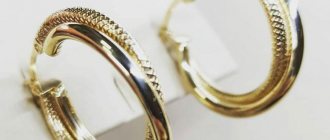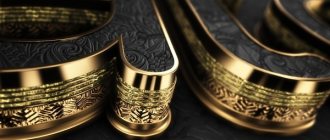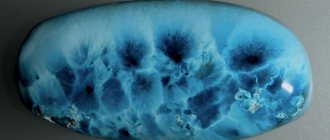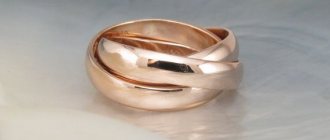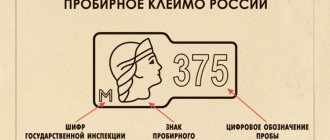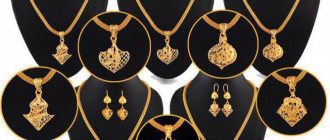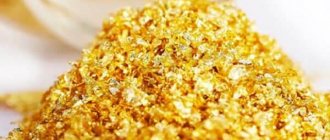Gold
has been used by mankind for many centuries. This metal is widely used in jewelry: a variety of jewelry is created from gold. However, this metal is never used in its pure form for a number of reasons.
Gold is a very soft metal, extremely susceptible to various types of deformation and corrosion. The fewer impurities in gold, the more susceptible it is to scratches and damage.
To create jewelry, other metals called “ligature” are added to gold, and there are several explanations for this:
- Diluting gold makes it possible to simulate the color and shade of the future jewelry.
- The weight of the product changes: it becomes lighter. Pure gold is a very heavy metal. It has a density of 19,621 kg/m3.
- Consumption is reduced, because pure gold has a very high cost.
- By adding alloying metals, the mechanical properties of gold are improved, since gold itself is quite soft. This point, perhaps, is the main reason for the mandatory dilution of gold.
Gold and its alloys
Gold alloys are classified according to color into white, red, yellow, green, pink and others. It is important to know that alloys of the same shade can be of different samples.
The characteristics that an alloy must have are determined by the participation of one or another component in its composition:
- To obtain, platinum, palladium and nickel are added to the alloy. Such compositions have a high melting point and are almost resistant to corrosion.
- Copper and silver make it possible to create an alloy from light yellow to red shades, as well as to achieve greenish and reddish tones. Such products have an average melting point, maintaining the plasticity of the metal and high malleability.
- To obtain an alloy with a low melting point, gold is diluted with zinc and cadmium. Such alloys are often used as solders.
So, the following components can be added to gold:
- Copper.
A bright red alloy can be obtained by achieving a copper content of 14.6%. It gives the composition hardness while maintaining its viscous properties. But copper makes the metal more susceptible to corrosion. - Silver.
A white alloy is obtained when it contains 65% argentum. With a silver ratio of 30%, the color will be white-yellow. When adding a small amount of silver, the composition will have a greenish tint. - Platinum.
Used to achieve a white alloy color. A white tint is obtained already at 8.4% platinum content. This metal also increases elasticity. - Palladium.
It is also used to obtain a white tint, but in this case it is necessary to add at least 10% of the substance to the alloy. The metal sharply increases its melting point, leaving its ductility unchanged. - Nickel.
Mainly affects the casting characteristics of the alloy, increasing its fluidity. The color of the composition changes to pale yellow. Nickel is a highly allergenic metal that can cause skin irritation when wearing jewelry for a long time. - Zinc.
Used to impart a slight greenish tint, significantly reducing the melting point. The presence of zinc in the product makes it more fragile.
Jewelry alloys
Pure gold and pure silver are very soft metals, but the alloy of these metals unexpectedly acquires a higher hardness than either of them alone. In addition, it is more ductile, has better malleability than parent metals, and melts at a lower temperature. Those. adding silver to gold improves its properties from a jewelry point of view. Copper and a number of other metals, called base metals, have a similar quality in relation to gold and silver.
The addition of a small amount of silver to gold makes the alloy pale yellow, but if you take gold and silver in equal parts, the yellowness completely disappears. An alloy of gold and copper, on the contrary, looks reddish: copper adds brightness to the noble metal. Therefore, for the jewelry industry, an alloy containing silver and copper is used to obtain a beautiful noble gold hue and high hardness of gold.
Often gold deposits are mined already fused with silver. Such a native alloy containing 45% gold is called electrum. At gold mining enterprises, metals are separated in order to then create various alloys with precisely taken proportions and pre-known properties.
Gold samples
There are several established systems for determining metal samples. The most famous of them are metric and carat.
In Russia, the metric system for determining samples has been used for a long time, as it is very convenient and understandable. This system displays how much pure gold is contained in one kilogram of the alloy. For example, if 1000 grams contains 585 grams of gold and 415 grams of impurities (ligatures), the product will be 585 fine.
Each sample has its own characteristics and it is difficult to say which one is better. To store the precious metal in bullion, 999 purity is used, i.e. gold is stored in almost pure form. While the most common standard for creating jewelry is 585.
As for the karate rating system, it is most popular in Europe and the USA. In this case, 24 parts of the alloy act as the base, and the sample shows how many full parts are gold.
So, if a product has a hallmark of 18K, this means that it consists of three-quarters gold and a quarter alloy. In metric parlance, this is 750 sterling. Jewelry is made from the following alloys: 9 carat, 10, 14, 18 and 24.
958 sample
The composition of this sample includes 95.8% pure gold
. It is as close as possible to the characteristics.
The hallmark corresponds to 23 carats in the karat grading system. 958 standard is extremely rarely used by jewelers to create jewelry. This is due to the prohibitively high cost of products and their susceptibility to various types of damage.
The composition of such an alloy, according to GOST 30649-99, in addition to the noble metal, may include the following components:
- Silver – 1.7-2.3%
- Copper – 1.2-2.4%
- Iron – up to 0.08%
- Lead – up to 0.003%
- Antimony – up to 0.003%
The alloy has a bright yellow color with a characteristic shine. It is used only to create some parts of products that are not subject to continuous physical impact.
958 standard is not sold in the form of bars and is sold only as scrap or jewelry.
The cost of the alloy is variable and depends on various factors, such as the place of production, the complexity of the work, the place where the product was purchased, etc.
Alloy 958 has not found wide use despite the fact that it is approved by GOST.
750 sample
This hallmark is very popular among jewelers and corresponds to 18 carats. It contains 75% gold, which is the most optimal ratio. , you can find out here.
A fairly high percentage of gold attracts buyers, and it is easy for craftsmen to work with this composition, since it also contains enough ligature (25%). 18k gold is easy to polish and process.
The color of a gold product of this standard varies depending on what constitutes the remaining 25%.
The most common option is white products, for which palladium and silver are used in a ratio of 20% to 5%.
The uniqueness of such products lies in their external similarity to natural platinum, however, their cost is 40% cheaper than platinum jewelry.
585 sample
This test can easily be considered the most popular in jewelry making. Rings, cufflinks, chains, bracelets, buttons, family heirlooms, etc. are made from it. 585-karat items do not fade over time and are very durable.
What is added to 585 gold? The shades of gold of this standard can be very different: white, red, pink, green, etc. It depends on the composition of the impurities. The 585 gold alloy classically contains copper and silver.
585 sample has an interesting origin. It appeared after the collapse of the Soviet Union as a replacement for 583 gold, which was not particularly popular. Being isolated from European countries, the USSR itself set standards and tests. By increasing the gold content by 0.2%, the inventors obtained the famous 585 standard, which meets all the requirements of both consumers and jewelers.
500 and 375 sample
500 standard is extremely difficult to find on jewelry counters today due to a number of disadvantages of such an alloy.
Despite the fact that it is approved for making jewelry, almost no one uses it. This is due to the very low casting properties of this sample. It has found its application as a standard for the inspection of jewelry.
375 gold is also rarely found in jewelry stores.
Products made from such an alloy quickly lose their attractiveness and shine, which is why the demand for them is extremely low. 375 standard is used in the manufacture of bracelets, cigarette cases, watches, and household items and interior elements are also inlaid with this alloy.
Understanding platinum
Platinum is a precious metal that visually resembles silver.
However, this is only the first similarity, which will not be difficult to distinguish. Silver has a warm tint, while platinum is rewarded with a noble white color. Comparing platinum with white gold is not entirely correct, because in fact, white gold has a quite noticeable warm undertone, which is neutralized by the top protective coating of rhodium or ruthenium. Yes, it is possible to alloy white gold without a pronounced warm tint, but in practice this alloy is practically not used. The minimum purity of platinum does not fall below 850, although the metal usually has an even higher value. The favorite standard of BENSES jewelers is 950 platinum.
Platinum products are more expensive than gold, but few people know why. The opinion has been established that gold is simply cheaper, but in reality this is not entirely true. The initial cost of pure metals per gram is approximately the same, sometimes even platinum can be cheaper. The difference begins to be felt the moment the jewelers get to work.
The 950 platinum alloy is significantly heavier than the 585 gold alloy. To be precise, platinum weighs 21 grams per cubic centimeter, while for gold this figure varies from 13 to 15 grams per cubic centimeter. Weight fluctuations are determined by the ligature.
Accordingly, in two visually similar products made of gold and platinum, the share of the precious metal itself differs significantly. Platinum is required almost twice as much as gold, and the final weight of a platinum product is significantly higher than the weight of gold jewelry. Hence the price difference.
Platinum, with its complex white hue, pairs perfectly with precious stones. The peculiarities of the metal allow you to securely fasten even high-carat stones without fear for the safety of fastening. We use copper, indium and gallium as alloys. When BENDES jewelers need to achieve maximum hardness, we add white gold. Depending on the percentage combination of precious metals, a certain standard is set on the jewelry.
In Russia you can find 850, 900, 950 or 999 platinum.
Yellow gold
Most jewelers prefer to work with yellow gold, which is a unique material. It is quite durable, but at the same time easy to process.
Yellow gold allows you to depict the most elegant and subtle patterns. Pearls, precious and semi-precious stones go well with it.
What is added to yellow gold? Typically, silver and copper
. The reasonable cost of these alloys makes yellow gold quite affordable in the price range.
Yellow gold is remarkable because it suits any skin tone. Moreover, it has the same value in all countries and continents. The price of such gold can vary quite widely and depends on many factors described above.
Cleaning yellow gold is quite easy: using hydrogen peroxide, salt and detergents.
Synthetic materials
Synthetic threads are widely used in medical practice. They are also available as absorbable and non-absorbable. The first include occelon and cacelon. They do not cause allergic or inflammatory reactions and are more reliable than catgut. Non-absorbable synthetic ligature - nylon, nylon, mersilene. They are inferior in strength to silk, in addition, a knot made of these materials can come undone, as they are quite smooth. To prevent this, you need to tie three to five knots. In orthodontic practice, a special ligature is used - elastic. It ties the archwire of the braces. A metal ligature is used to connect bones and joints. The threads must be strong, corrosion-resistant, elastic and smooth. They are made from titanium, silver, nickel wire, steel.
White gold
White gold typically contains platinum, silver, palladium and nickel
. In terms of price, white gold will always be more expensive than yellow gold, which is associated with the cost of the alloy. You should be especially careful when handling products containing nickel, as this metal causes allergies and skin reactions in many people.
The ideal option is white gold with the addition of palladium and platinum, however, such an alloy can be difficult to find, and the prices for such products are extremely high. Often such jewelry is produced in a single copy or in limited quantities.
White gold jewelry must be plated with rhodium. Otherwise it will have a grayish tint. In addition, this coating protects the gold from microscopic damage.
The disadvantage of white gold is that the coating wears off over time and the product becomes dull.
In this case, you need to take it to a jeweler to update the coating. White gold is very delicate and delicate: even chlorine contained in running water can harm it.
Money circulation and the law of money circulation
Money is in constant movement between three entities, such as:
- individuals;
- economic entities;
- government departments.
Money circulation is the direct movement of money when they perform their functions in cash and non-cash form.
Money is concentrated among the population in the cash registers of enterprises, in the current accounts of organizations and in the state treasury. The demand for money arises in the case of transactions, payments for goods and services. The higher the overall value of goods and services, the more money is required to complete transactions. Such monetary circulation is carried out in two main forms:
- cash - those that are in circulation, for example, metal and paper. They provide the purchase of various goods and services. The shortage of metal money creates a problem for buyers and reduces the seller's revenue;
- non-cash money is fixed cash in financial and credit institutions, such as banks, savings banks and in the form of payment orders - requirements. When they are used, money changes hands, not in the form of banknotes, but mainly in the form of inflation.
Along with money, there are other securities in circulation: stocks, bills, bonds, traveler's checks and more.
There is even a law of money circulation. This law was discovered by Karl Marx. It establishes the amount of money needed to perform the functions of a means of circulation and payment.
The amount of money in circulation depends on three main factors:
- the number of goods and services sold on the market;
- price level for goods and services;
- velocity of money circulation.
All these factors are determined by the conditions of production itself. The higher the level of social division of labor, the greater the volume of goods and services sold on the market. And at the same time, the higher the level of labor productivity, the lower the cost of goods and services.
The total amount of money in circulation cannot be unlimited, since in order to sell goods entering the sphere of circulation, the amount of money must be clearly and precisely determined. The greater the sum of prices of goods, the more money is needed to sell them. There is a direct relationship here. The second important element is the speed of circulation of money, since money is constantly returned to circulation. Thus, the faster each monetary unit carries out its turnover, the less money is needed. There is an inverse relationship here.
The amount of money needed for the sphere of circulation is significantly influenced by the function of money as a means of payment. Since the sale of goods on credit means that money is no longer needed for the movement of goods, this reduces the amount of money in circulation and thus increases the sum of the prices of goods that were sold on credit and the payment period for which has already arrived, which requires additional amounts to make these payments . In addition, part of the payments is mutually extinguished. Taking into account all these factors allows us to accurately determine the amount of money needed for circulation.
However, today it is difficult to predict the likely economic situation in the country, as well as on the world market. That is why the requirements of the law of monetary circulation in a market economy are taken into account on the basis of determining the state of monetary circulation, i.e. actual balance and development, as well as the implementation of appropriate monetary policy based on modern monetarism.
From the formulated law we observe an important principle of monetary circulation. Its essence lies in the fact that the money supply must correspond to the needs of circulation. Maintaining balance in the economy, balancing demand, as well as supply, largely depends on the volume of money supply
The money supply should grow in proportion to the growth in the volume of goods and services or decrease in accordance with the decrease in the volume of the commodity supply. Changes in the money supply are determined through the so-called money multiplier, which reflects the role of the banking system in regulating the money supply.
Thus, you can see how all these processes developed throughout history and have reached the present day.
We briefly looked at what a ligature is and related concepts. Leave your comments or additions to the material.
Black gold
Black gold is extremely rare and its cost is high compared to other types of gold. It is obtained in several ways: by adding various alloys to the composition, or by spraying ferrous metal powder onto a gold item. Most of the recipes for making such gold are kept secret.
Black gold looks very impressive, rich and elegant. Jewelry made from it is suitable for both men and women. Compared to yellow gold, black gold is more fragile, but, without a doubt, more valuable and expensive.
Other colors
Modern technologies make it possible to create gold alloys of almost any shade, but not all of them have sufficient characteristics to enter the wide market. So, there are several technologies for inventing purple gold.
But such products are not always practical.
In Uralsk, scientists at the Physical Institute of Metals have come up with a way to create green, purple, blue, violet and black gold.
In addition, scientists have discovered the fact that when certain conditions are compared, the surface of gold can acquire different shades. By experimenting with yellow gold, it was possible to achieve a deep blue tint of the alloy.
Methods for obtaining colored gold
There are several ways to obtain colored gold:
- Applying a special coating to the surface of the finished product.
It is carried out due to the thermal and chemical reaction of metal alloys with the environment. - Oxidation.
This method involves creating decoration with artificial colors. An oxide layer is applied to the surface of the jewelry. - Patination.
In this case, chemical treatment of the alloy, which contains copper, occurs. - Oxidation.
Gold products are oxidized in air for 30-60 minutes at a temperature of 750-950 degrees Celsius. Thus, cobalt is used to obtain black gold. - .
Application of rhodium plating on finished products. - Galvanostegy.
This method involves the use of solutions with the addition of special dyes that form a special layer on the jewelry and give it the desired color. - Recoloring gold
is the youngest, recently discovered method of obtaining colored gold. At the atomic level, gold is milled with an ion beam. The structure and depth are selected, light waves are controlled. Thanks to the ability of metals to absorb and reflect waves, any shade of gold can be obtained.
Thus, gold has been valued from time immemorial and is still considered a noble metal. A large selection of alloy compositions makes gold products accessible to people with different income levels.
Pure gold is soft to the point that it can be kneaded with bare hands. In order to give it strength, manufacturers add various elements to gold, which do not spoil, but improve the appearance and characteristics of the finished product. Auxiliary alloys, which can consist of several components, are called “gold alloys”. High quality chemical elements without impurities are used as alloying additives.
Ligature and non-ligature braces: comparison of systems
Both types of structures do a good job of correcting the bite and aligning incorrectly growing teeth. But there is still a difference between them: let’s see what differences these two systems have:
- Ligature-free braces look neater and more aesthetically pleasing. Its clasps are smaller in size, and the absence of ligatures makes the design less cumbersome than a ligature one.
- It is easier to care for a self-ligating system, while pieces of food and plaque accumulate under the elastic bands and wires, and it is necessary to pay special attention to oral hygiene when wearing ligature systems.
- Non-ligature braces require correction much less frequently than ligature braces - approximately once every 6-8 weeks versus 3-4 weeks when using the classic system. For some patients, this is a very important point, since they need to visit their orthodontist at a certain time, and this is not always possible.
- Classic ligature systems cope with all types of pathologies, while self-ligating systems cannot cope with too complex jaw anomalies.
It cannot be said unequivocally that non-ligature braces are better than ligature braces - and vice versa. Both types of structures work in a similar way, helping the teeth to move into the correct position or correct the bite. The final decision is made by the orthodontist, taking into account several factors: the type and degree of pathology, the individual physiological characteristics of the patient, and finally, the budget for treatment.
general information
Anyone who has ever bought jewelry has noticed that the sample indicates the amount of pure gold. There is a name tag on the product. In turn, samples are divided into three measurement systems:
- metric;
- carat;
- spool valve
Buyers more often deal with the metric three-digit system, which indicates the amount of precious metal per kilogram of alloy. During the Soviet era, jewelery of 583 standard was present on the shelves of jewelry stores, where the percentage of other components was 41.7%. Today, such a ratio is very rare, and the most popular is gold 585 alloy. Products with this indicator have excellent performance properties and look great.
Ligature is an alloy that changes the color of a precious metal
What components determine color:
- White - 585 gold (ligature: platinum, silver, nickel, palladium) contains a little more than half of the yellow precious substance.
- Red - obtained by adding copper.
- The yellow tint for a noble metal is natural; in such compounds, copper or silver alloy is used.
- Purple decorations are obtained by adding 750-grade aluminum to the material.
- Ruthenium, chromium and rhodium are present in black rings, bracelets or pendants.
- Greenish jewelry uses rubidium and silver alloying additives. These things look luxurious, but are not very durable.
The highest price is for platinum alloys. Nickel analogues are cheaper, but they do not have a pronounced shine. These works are similar to silver ones.
The shade of the decoration depends on what kind of ligature it contains. Metal added singly or a combination of several elements gives the craft originality and uniqueness.
Metric measurement system
In Russia they use the metric measurement system, expressed in three-digit numbers, while English-speaking countries use the carat system. Zolotnikovaya is considered obsolete and is practically not in demand today.
- 375 – an alloy of gold, copper and silver, where the content of the first element is only 37.5%;
- 585 (58.5%) – in terms of characteristics, such products are the most practical, and they also look aesthetically pleasing;
- if you have a 750 alloy in front of you, gold is present there in an amount of 75%;
- 999.9 (four nines) - contains only 0.01% foreign impurities. But such a product is not used in the jewelry industry because it is too soft and is intended only for the formation of ingots.
There are other percentages, but such items are usually made to order.
The price of a ring, pendant or earrings depends on the percentage of precious metal in them, the presence of stones and the complexity of the work. Products with a minimum gold content are classified as costume jewelry. However, in underdeveloped countries of Africa and Asia, sellers vying with each other to praise the product with 16.6%.
The subtleties and nuances of compositions are the work of professional jewelers. The buyer only needs to understand the samples. The presence of a ligature improves properties, reduces the cost of the final product and allows craftsmen to create real masterpieces. Thanks to the variety of alloying additives, today every buyer has the opportunity to purchase a luxury product according to his taste and wallet.
Such products are now at the peak of fashion
One of the most important criteria for assessing the quality of gold products is the metal alloy or sample used. The latter indicates the percentage of precious metal and alloy (impurities) in the composition. Let's try to figure out what types of tests there are. There are 2 systems in the world:
- metric,
- carat
In Russia, the first one is traditionally used, indicating the amount of precious metal in 1000 parts of the alloy. The content of precious metal in products in our country is strictly controlled at the legislative level with the help of GOSTs. According to their requirements, the hallmark of white gold has 5 types:
- 375 - the pure gold content is 37.5%, the rest is zinc, silver and nickel. A relatively inexpensive composition designed for the mass consumer, the products gradually fade when exposed to air.
- 500 - valuable metal makes up exactly half of the alloy, the other part consists of copper and silver. The low castability of the composition increases the labor intensity of the product processing process, so this type is not very common.
- 585 - the standard of white gold consists of 58.5% of the noble metal, to which copper, silver, palladium, and nickel are mixed. A widely used and popular alloy that produces strong, hard, low-oxygen products.
- 750 is an alloy consisting of 75% gold, the remaining 25% is silver, palladium, platinum, and sometimes nickel. An expensive composition used for especially valuable, filigree works.
- 958 is almost a golden absolute. It is very soft, so it is practically not used in jewelry, because products made from it are fragile, easily deformed and erased. However, it is used to make bank bullion.
Degeneration of money
In order to understand why it was worth turning to the use and introduction of a ligature, one should turn to history. Degeneration of money, or
Demonitization is a historical process in which gold was used as a common equivalent for various goods. Initially, it was in use in its natural form - in the form of nuggets. This is how it was used in trade by weight. We needed absolutely accurate scales and a guaranteed sample. In Egypt and Babylon they used gold and silver plates, thus in exchange for goods they cut off the necessary pieces from these plates. Later, in Egypt they began to make rings, cakes, and ingots of various shapes, which always had the same exact weight. With the passage of time, for example, a design was embossed on flat cakes, but there were no dates. In fact, at that time money consisted of electrum - an alloy of gold and silver. Then they were made from pure gold, on which a round seal was placed with the hallmark and weight. Such monetary units received their name from their measure of weight, later in honor of gods and goddesses. For example, at the temple of the goddess Juno, a mint was opened. The English word “money” comes from her name. The evolution of the formation of money can be observed according to the following scheme: nuggets > plates > rings > beans > cakes > coins. Almost simultaneously with the appearance of the monetary unit, the fact of their counterfeiting also arose. They began to add copper or iron to them, and their characteristic trimming.
Essentially, a coin is a piece of gold that has a certain weight, denomination and coat of arms. Who verified its authenticity? Coins were valuable not by weight, but by face value.
Everyone knows that gold is a very soft metal. It literally “sticks to your hands.” Therefore, with constant use, they wear out. The average gold coin loses 0.07% in weight every year. This is very clearly seen from the well-known fact that gold-plated things quickly lose their gilding.
Ligature in white gold
It is not difficult to remember what standard a product is made of white, yellow, pink, red or black gold, because the metric system in Russia is the same for all gold varieties. 585 white and ordinary gold items contain an identical percentage of the precious metal. However, their costs may vary significantly. Why does this happen?
Stylish bracelet
The price of the product is influenced not only by the standard of white or yellow gold, but also by other factors. The quality of the ligature is of great importance. A wide variety of impurities can be added to a jewelry alloy:
- copper,
- cadmium,
- silver,
- palladium,
- nickel,
- bronze,
- platinum.
Some metals are precious, others are not. But not only the price of jewelry depends on the ligature, but also their properties. Thanks to silver, the alloy acquires special softness, the melting point decreases, and the color changes - from yellow-green to completely white. With the help of copper, the hardness of the composition increases, the reddish tints increase, but the anti-corrosion properties decrease. Palladium and platinum increase the melting point and color the composition a noble white color.
Professional jewelers select the appropriate composition for products. An ordinary buyer does not need to delve into all the details; it is enough to navigate through samples.
Why is metal ligation performed?
The addition of alloy metals in many cases is extremely necessary; they significantly increase wear resistance and also change some characteristics of the main component of the alloy. What properties are affected by the admixture of an auxiliary metal:
- melting point;
- fluidity;
- strength;
- color;
- improvement of intercrystalline structure.
Metal alloy is a process that has a “great future.” Due to the considerable number of components, different alloys can be created. The use of this process has made it possible to obtain new types of alloys that are widely used in various sectors of human activity. Moreover, replacing such alloys with one of the components of their composition is categorically excluded.
Features of white gold
Jewelry for a businessman
White gold became widespread after 1920. Until that time, silver or platinum were considered the most suitable metals for cutting pearls and diamonds due to their ideal color combination. However, silver tends to oxidize quickly, so the product loses its original appearance.
Platinum is not only significantly more expensive, but also more difficult to process due to its refractoriness. The discovery of a method for bleaching yellow metal created an easy-to-use composition that was practically not inferior in external characteristics to platinum. They began to produce jewelry with complex shapes from white gold, which could not be created from platinum. Thus began a new era in the history of the precious metal.
White gold has a huge number of shades, but to obtain a noble whiteness similar to platinum, high-grade compositions (from 585 and above) are used. Low gold grades exhibit poorer color consistency and reflectivity when bleached. Not very pure shades can be hidden under a rhodium coating, which gives the jewelry a cool blue color. This metal from the platinum group significantly reduces wear, increases hardness, protects against scratches, and gives products a bright shine. However, the rhodium plating also needs to be renewed periodically, carrying out the procedure of repeated “metalization”. The following can be used to bleach gold:
- platinum,
- palladium,
- nickel.
Thanks to palladium, products acquire a white-steel tint. Platinum acts more intensely, painting the alloy an even white color. Nickel, being a base metal, still effectively bleaches gold, however, retains a subtle yellowness. In addition, it has been statistically established that every 8th person may be allergic to nickel in the form of dermatitis. Therefore, since 2000, European countries have stopped using this metal in white gold jewelry. However, in other parts of the world, nickel is still actively used. Therefore, if you are prone to allergic reactions, be sure to inquire about the composition of the product.
White gold alloys are actively used for inserts with precious stones, especially pearls and diamonds. It is generally accepted that such a frame reflects the shine of stones well, does not distort the color, and creates the illusion of additional lighting.
Compared to yellow gold, white gold has increased resistance to external influences. This is a fashionable and sophisticated material that is always popular with leading jewelers.
5.1 Ligature Ligature is an alloy of other metals that is added to gold, silver, platinum and palladium to increase strength and stability, the desired shade. Copper, silver, palladium and some other non-ferrous and precious metals can serve as ligatures.
5.2 Sample colors Products with the same sample may be of different colors. The color of jewelry gold can vary from red to white depending on the content of impurities. Impurities also make the product harder and more durable, because gold is a soft metal. Zinc, silver and palladium give metals white and yellow-green colors, while copper produces alloys ranging from orange to red.
White products can be either gold or silver. Platinum ones are also very rarely found in practice. White gold, usually 583 ,585
and 750* samples;
Silver can also be white. By the degree of oxidation of the surface, if it is cloudy and not shiny, we can judge that it is not gold, but silver;
Platinum does not oxidize over the years and retains its white-gray hue;
There are combined products made from different alloys of precious and non-precious metals;
There are three-color bracelets in the form of woven “braids” from 3 different alloys. On large chains or bracelets of 583* purity, there are clasps - bridges made of 500* purity. The lower the sample, the harder the alloy, and therefore the lock will be able to spring well;
There are engagement rings made of base metals, but well polished and waxed to slow down the oxidation of the surface. Upon quick inspection, they can be mistaken for gold.
Rule: when examining, determine by color how many types of alloys the product consists of. Each such part that differs in color must be checked separately with acid. It may turn out that they are of different samples. To avoid mistakes, all products must be tested by making a cut and dripping with acid!
5.3 Influence of alloying components on the properties of gold alloys
5.4 Non-ferrous gold Adding additional elements to the alloy, for example, palladium or zinc, gives the precious metal a different color. This produces pink, yellow and white gold.
Important: gold purity does not affect its color. Gold of the same purity (fineness) can be of different shades.
White gold is an alloy of gold with platinum, palladium or em, having a white color. Rhodium plating is often used to enhance whiteness. Before the invention of white gold, diamonds were often set in silver because the color of a diamond was not always pure white. White gold gives any shade of stone a white color and white shine. It is also more durable and weather-resistant than traditional reddish. White gold products have been considered very fashionable over the past few years.
Yellow gold - has the true color of gold. It is for this reason that it has been valued since ancient times and gained fame as a precious metal, and also became a symbol of royal power and wealth. Yellow gold is popular in the West as a metal for wedding rings. There is a common belief that yellow gold best symbolizes the warmth and love of spouses. Yellow gold is mostly 750 fine.
Red gold is the most popular and affordable type of gold in Ukraine. Copper gives the alloy a reddish tint.
5.5 Rhodium plating of jewelry. Rhodium is the brightest and hardest metal of the entire platinum group. Due to its remarkable properties, rhodium has found wide application in jewelry production. For example, the metal is used as a strengthening element in the composition of platinum and palladium. Rhodium plating perfectly emphasizes the beauty of diamonds, their purity, and if necessary, it skillfully hides some defects. With its help, products become more wear-resistant, and in ten years they will look as if you bought them just yesterday. The anti-corrosion properties of products coated with a thin layer of rhodium will be significantly higher than those of ordinary gold or silver products. As you know, there are people who are allergic to gold, but at the same time love to wear it.
Rhodium plating successfully resolves this situation, since rhodium is a good anti-allergen.
5.6 Gilding Gilding is one of the oldest ways to decorate jewelry. When gilding a piece of jewelry, a thin layer of gold is applied to it. In the pawnshop business, silver jewelry coated with a thin layer of gold is often found. They bear the state hallmark for silver alloys (“barrel”) indicating the standard of the base metal – “875 », «925
" etc.
Rule: do not accept gold-plated products as gold, since the gilding in such products is of no value!
5.7 Blackening. Blackening of jewelry is used as an artistic element, or to hide minor defects (in this case, individual parts, such as connecting seams, are blackened). The basis of blackening technology is as follows:
Small indentations are engraved, embossed or etched into the product. An alloy consisting of silver, copper, lead and sulfur is melted into the resulting pattern. There are various variations in the preparation of the alloy, its application and melting.
Most jewelry owners don't even know what a gold ligature is. In fact, the appearance and durability of jewelry depends on its characteristics.
Ligature fistula
Most serious operations end with the application of a ligature - a special thread that stitches together damaged tissue layer by layer. Typically, during surgery, the wound is thoroughly washed before suturing begins.
This is done using resorcinol, chlorhexidine, iodopirone and other solutions.
If the thread becomes contaminated with bacteria, or the wound has not been sufficiently treated, then suppuration of the ligature occurs and, as a result, a ligature fistula is formed.
A compaction called a granuloma forms around the thread that tightens the edges of the wound. The suture material itself, collagen fibers, macrophages and fibroblasts enter this compaction.
The ligature itself is not encapsulated - it is not limited to the fibrous membrane. After such suppuration is opened, a fistula is formed.
Most often, one fistula is formed, but there may be several, depending on where the ligature remains.
Typically, such a complication makes itself felt quite quickly, even during the patient’s stay in a medical facility, therefore, during a routine examination by a doctor, the symptoms of a ligature fistula are identified and treatment occurs in a timely manner.
The purulent process can last for several months if you do not consult a doctor in time and do not remove the cause of the suppuration.
Most often, ligature fistulas appear when a postoperative wound is sutured with silk threads. It is worth noting that at the present stage, surgeons try to use suture material that is absorbable, so as not to remove the sutures later, for example, catgut.
Symptoms of ligature fistula
Usually, a fistula cannot be ignored - its external signs are clearly expressed.
- Firstly, compaction and infiltration occurs around the wound channel. The bumps that appear become hot to the touch.
- Secondly, near the scar left after the operation, you can clearly see inflammation - redness will develop as the ligature is applied.
- Thirdly, the wound begins to quickly fester and purulent contents are separated from the outlet. The volume of discharge may be insignificant, but with a rapidly developing process, noticeable weeping may be observed.
- Fourthly, such processes provoke swelling of nearby tissues and an increase in body temperature to significant levels (39 degrees and above).
Treatment of ligature fistula
Treatment of a ligature fistula must begin as soon as possible, since this is a serious complication that can lead to secondary infection, disability, and in severe, advanced cases, sepsis, which can lead to death for the patient.
Only a doctor should prescribe treatment, and if suppuration occurs at home, the patient must be urgently sent to the hospital. Treatment of ligature fistula can be implemented in two ways - surgical and conservative.
The most commonly used surgical treatment consists of removing the infected ligature, after which the patient must undergo a course of antibiotic therapy. The patient is given a small incision to allow the pus to drain.
This will protect the patient from the development of phlegmon - purulent melting of tissue, as a result of which it will be much more difficult to cure the disease. If the ligature can be removed, the fistula is closed. Otherwise, a second attempt is made after a few days until the ligature is removed.
In severe cases, when the ligatures are multiple and entire fistula tracts are formed, excision of the entire postoperative scar along with the remains of the ligatures is indicated.
The wound surface requires special care - the affected area must be washed with special solutions to rid the wound of pus and avoid further development of the pathological process.
Typically, hydrogen peroxide or furacillin is used for this purpose. If excess granulations are present, it is recommended to cauterize them.
Conservative treatment is possible only when the process is just beginning and the amount of discharge is minimal. In this case, the patient removes dead tissue around the fistula and thoroughly washes out the pus. If possible, also cut off those threads whose ends come out. Next, the patient is given antibiotics and immunity boosters.
Prevention
To avoid the occurrence of a ligature fistula, it is necessary to properly treat the wound before suturing and use only sterile suture material. Also, when the first signs of this complication appear, it is necessary to provide timely assistance. Usually the outcome is favorable.
Why do you need a ligature and is it possible to do without it?
In the jewelry industry, the alloy for gold is extremely important - by adding various elements to the alloy, you can achieve significant changes in the characteristics of a gold product, such as strength or appearance. It should be taken into account that only pure metals are used as an additional element, without any impurities. This does not mean that gold can only be mixed with one specific element; the combination of several metals is allowed and quite successfully used. Pure gold is a rather soft and very ductile metal, and such jewelry made from it will be quite difficult to wear without worrying about its safety. This is why a ligature is used - by adding other elements to it, it becomes possible to significantly increase the strength of the product.
A little history
The fact that precious metal can be given a wide range of shades has been known since ancient times. Colored gold was first used in the jewelry industry in the 19th century. This happened in connection with the discovery of new noble metals - osmium, rhodium and palladium. At the same time, experiments began to be carried out to introduce them into precious alloys. Despite the fact that the components were known, the technology of joining metals was kept in the strictest confidence by jewelers.
Already at this time it became clear that the alloy in the alloy affects the color and strength of the products, but not their quality. The impurity content should not exceed the permissible 0.17%. Therefore, at present, regardless of what metal was used as a master alloy, the general gold-bearing alloy is considered precious.
What is it?
The amount of pure gold is indicated in the hallmark of the jewelry. There are 4 types of samples: metric, carat, spool and lot. The most popular is metric, consisting of 3 digits: they indicate the amount of gold per 1 kilogram of product mass. For example, fineness 999 means that in one kilogram of the alloy there is only 1 gram of alloy - everything else is pure noble metal. But it is unlikely that you will be able to wear such jewelry successfully, due to the softness of the material. There are several samples:
- 375. the lowest sample, in which 62.5% is ligature. Products with such a hallmark are notable for their low cost, but are significantly stronger and more durable than more expensive jewelry;
- 583, “Soviet” gold. Today, the manufacture of goods from this alloy is not carried out. The share of occurrence of other metals is 41.7%;
- 585. The most popular hallmark is a stamp containing these numbers, which are found on almost every piece of jewelry. Perfectly combines high performance characteristics and excellent appearance. The ligature accounts for 41.5% of the total mass;
- 750 sample. This product accounts for 75% pure metal. Products made in this way are highly expensive, since the composition also includes precious metals;
- 958 standard is practically not used in jewelry. Bullions are usually obtained from it, which are then used in the banking industry.
How does the ligature depend on the color of the decoration?
Depending on the elements added to the ligature, the shade of the resulting products also differs: White
.
Appears as a result of mixing the precious metal with palladium, platinum, manganese or nickel. The composition was considered one of the most popular at the beginning of the last century. Yellow
.
The shade inherent in a natural noble metal. The alloy contains only copper and silver. Red
.
Red or royal gold is obtained by adding copper to the base metal. Products made using this method are highly durable. The green tint
is obtained by adding silver or rubidium.
The greater the amount of silver, the lighter the product will be. But the resulting items are quite fragile, despite their stunning appearance. black
product owes its appearance to the presence of rhodium or ruthenium in the alloy. Compounds of chromium and cobalt are used as analogues, after which the surface of the objects is oxidized artificially.
What rules must be followed when wearing a ligature braces system?
If caring for non-ligature braces is quite simple, then when wearing ligatures, careful attention should be paid to oral hygiene. In addition, you must follow all the doctor’s recommendations so that the process does not take a long time and leads to the desired result:
- If you feel that the ligatures have loosened earlier than your scheduled visit to the clinic, do not wait, but visit a doctor and he will promptly replace them. Weak fixation in a certain place can worsen the results achieved.
- White or light-colored rubber bands quickly turn yellow from tobacco or some products and look unsightly. They can be removed during meals if the type of fastening allows it. If the pathology is complex and the elastic bands are applied in a complex cross pattern, then this should not be done.
- It is advisable to use not only toothbrushes, but also special brushes, as well as irrigators - this way you can clean the entire structure, even in inconvenient places, thoroughly removing food debris. During hygiene procedures, simple ligatures can also be removed periodically.
Before installing any braces, whether ligature or self-ligating, the condition of the teeth must be in perfect order: all dental diseases must be cured and professional cleaning must be carried out. Any braces systems are installed only in a completely healthy oral cavity.
Why is the decoration yellow or white in one test?
The white tint of the product is due to the presence of the following metals: platinum, palladium or silver in the alloy. The most expensive alloy is mixed with platinum - not all consumers can afford such jewelry. Compositions with nickel are more accessible, and they can be identified by their less bright shine, vaguely reminiscent of jewelry silver. But it is worth knowing that products made from this alloy negatively affect the health of the owner, often causing allergies. Adding only 1/10 of platinum often gives the composition shine and a distinctive white color, significantly increasing strength and increasing the material’s resistance to chemical attack. 585 standard contains a little more than half of gold, the rest consists of silver or platinum, which ensures the white color of the product. Impurities of palladium or nickel give a barely noticeable yellowish tint. To obtain a pronounced white color, the composition is additionally coated with a layer of rhodium, an element belonging to the platinum group of metals, which gives the product high resistance to mechanical stress. The cost of this metal exceeds the cost of gold, and for this reason the value of such jewelry is comparable to the value of objects made of pure precious metal. Also, such decorations are absolutely harmless to health.
The difference between white gold and silver jewelry
Despite the external similarity, there are several differences by which you can find out whether the product is silver or gold
- Try. For silver jewelry it is 925. White gold is found in stores only 585 or 750.
- Gold items are significantly harder than silver items.
- Silver does not shine as brightly as white gold.
A ligature in gold allows you to completely change the properties of the metal, making it possible to obtain real masterpieces. It is thanks to the chemical properties of various alloys that today everyone can find jewelry to suit their taste.
